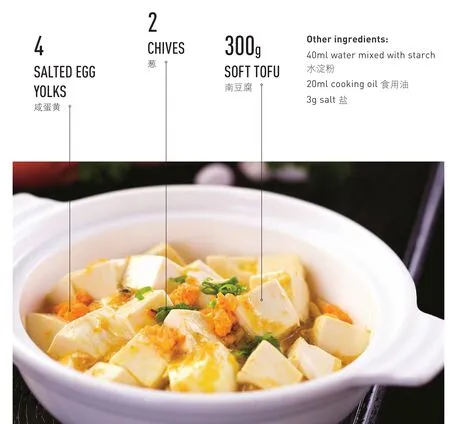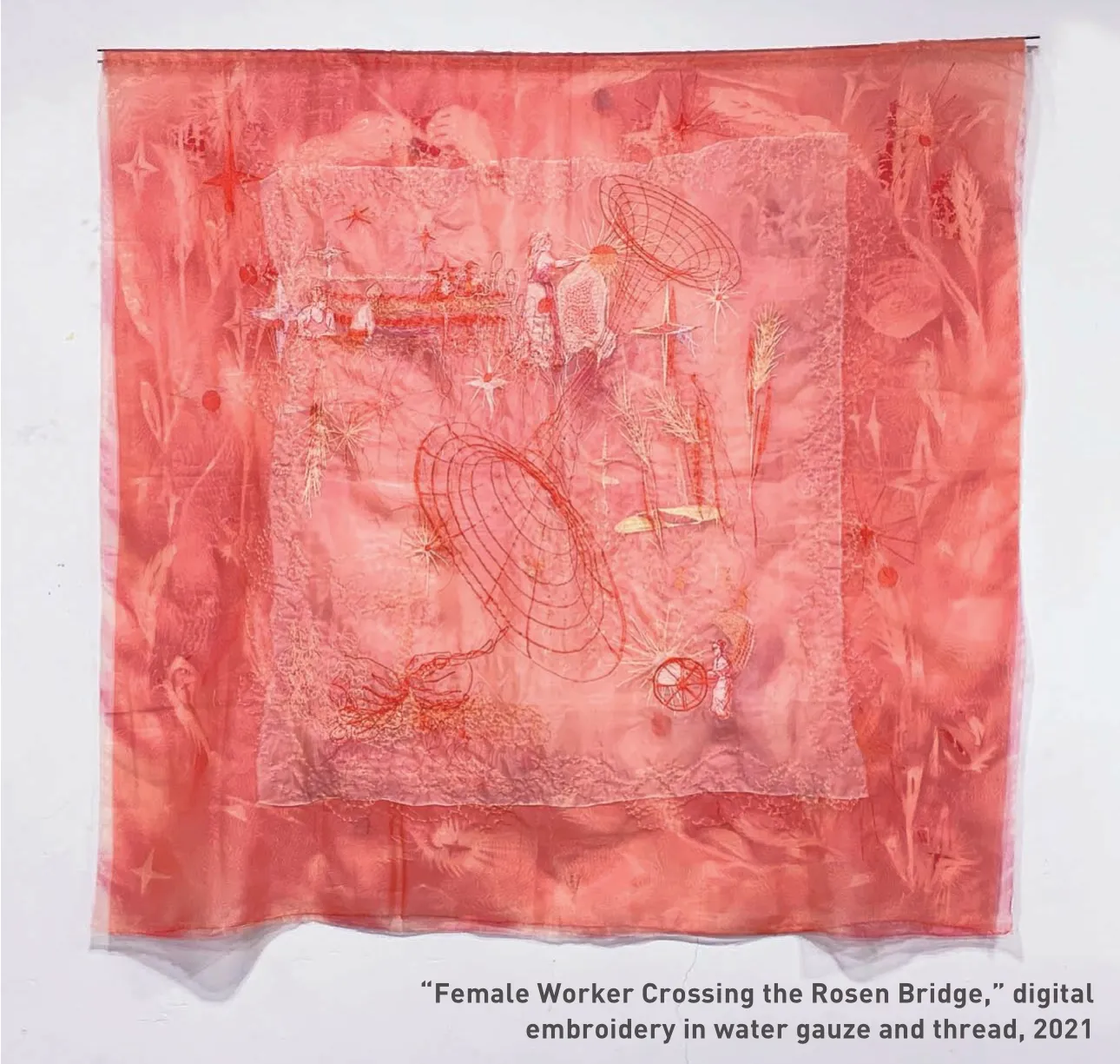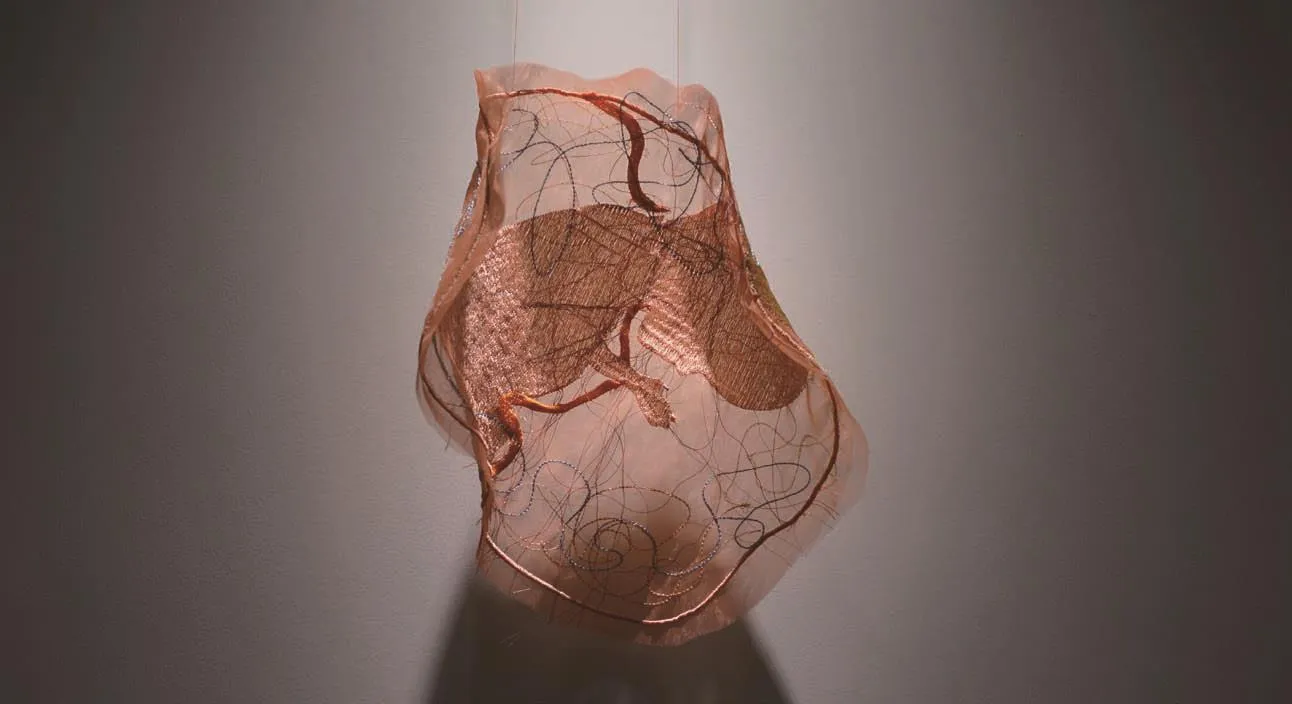ONLY YOLKING
BY TAN YUNFEI (谭云飞)
This well-known summer dish serves up tofu swimming in a golden stew of crab roe—or is it egg yolk?
蟹黄豆腐:豆腐配“黄金”,炒出鲜香滑嫩

If ancient Chinese gastronomes had had social media, much of their time might have been consumed by sharing and
commenting under gourmet pictures of crab.“Fresh, fat, sweet,and greasy, white as jade, and yellow as gold.Crabs have the best color,aroma, and flavor that nothing else can compete with,” scholar Li Yu(李渔) opined in the 17th century in his bookLeisure Notes(《闲情偶寄》), where he described raising his own crabs in 49 vats in autumn and preserving them in yellow Shaoxing rice wine to be enjoyed for the rest of the year.
Over 1,000 years earlier, Emperor Yang of the Sui dynasty (581-618)rated the wine-soaked and honeyflavored crabs sent as tribute from Jiangdu (present-day Yangzhou,Jiangsu province) as his “Number One Food,” and would have them served to him with their shells wiped clean and wrapped in dragon-andphoenix patterned gold foil.Even the contemporary Chinese food writer Cai Lan (蔡澜), born in Singapore in 1941, wrote in his essay “Ode to Crabs (《蟹颂》),” “It is not known who was the first person brave enough to try eating crabs, but they would be granted a Nobel prize if they had lived in modern times.”
Despite the popularity of crabs among emperors and literati, the golden orange crab roe seems to be more widely recognized today.Honored among today’s foodies as“ocean gold” for its oily flavor, grainy texture, and rich nutrients, crab roe inspired many dishes and desserts of Chinese cuisine, including crab roe tofu (蟹黄豆腐).This dish of unknown origin calls for cooking soft bean curd in a stew of crab roe.
“Ocean gold” doesn’t come cheap though.Due to the high cost and difficulty of extracting the roe, the vast majority of cooks replace crab roe with the yolk of duck eggs that have been preserved in salt brine.Salted egg is acclaimed for its own merits, but its golden yolk also resembles crab roe in color, texture, and taste.It is known for having a sharp, salty flavor and a firm,gelatinous texture.The yolks are also traditionally used for stuffing moon cakes and Chinese rice puddings, orzongzi(粽子).
In many parts of China, such as Zhejiang and Jiangsu provinces, salted eggs are traditionally consumed during the Dragon Boat Festival in the fifth lunar month, as it is believed to help people dispel moisture and toxins as spring turns to summer.Crab roe (or egg yolk) tofu is a signature dish of Beijing, Zhejiang, and Jiangsu cuisines,and the salted egg yolks from Gaoyou,Jiangsu, are especially commended for their reddish color and rich oil.
Steps:
1.Wash and cut the tofu into small cubes, and chop the chives
2.Cook the tofu cubes in 600ml of boiled water with 1g of salt for 1 minute, and then drain
3.Mash the salted egg yolk
4.Pour the cooking oil into a wok and fry the mashed egg yolk over low to medium heat until it bubbles
5.Add the tofu cubes to the wok and mix them evenly with the yolk
6.Add the starched water and the remaining 2g of salt and fry for 2 minutes
7.Sprinkle with chives and serve

Fiber artist Yue Mingyue uses airy gauze and yarn to explore subjects of great weight, with emotional
depth thinly veiled behind ethereal beauty.Yue’s work is often deeply personal, inspired by childhood memories such as her mother’s kidney failure, which left Yue plagued by the fear of death in her family as a young teenager.
In memory of her mother’s hysterectomy, Yue exhibited “Blessed Be the Fruit” at the Tsinghua University Art Museum in 2018,encouraging gallery-goers to wrap themselves up in a concatenation of long crimson fibers that rekindle the safety and warmth of being returned to the womb.She is best known for making installations with black and red gauze, weaving together life and death in a series of centerpieces that present death’s presence in life, and vice versa.
Yue describes her work as something that “may not be in sync” with mainstream Chinese art language.Her art also updates embroidery and textiles, traditionally feminine crafts, in order to explore women’s issues in modern China.In her most recent piece, a work of embroidery called “Female Worker Crossing the Rosen Bridge,” she uses symbol from Western medieval tapestry to explore what stays the same for women in rural China in an age of great change.
Why do you see life and death as being linked?
The fact that life and death coexist is something everyone in the world has to recognize repeatedly from the moment they’re born.They might start by recognizing that people around them die, then learn that they themselves can die, and then come to

“Female Worker Crossing the Rosen Bridge,” digital embroidery in water gauze and thread, 2021

Born in a small village in Liaoning province in 1996,Yue Mingyue is a fiber artist based in Beijing.She received her Bachelor’s in design from the Department of Arts and Crafts at Tsinghua University in 2018, and is currently a PhD candidate at the same University.She is also a researcher on the future directions of fiber art through post-pandemic online exhibitions and an exhibition director for the 2020 Sino-US Technology and Innovation in Fiber Art Exhibition.Her work has been exhibited at Tsinghua University Art Museum in Beijing, the M50 Creative Park in Shanghai,and Cité Internationale des Arts in Paris.accept it.The last work in my “Death”series, which is a film calledOn and On, is about an infant—when it was born it was very happy, but one day it realizes its life has a limit.Then it starts to resist death, before going on to accept death.The acceptance of death becomes a part of its life.


“From Womb to Tomb,”gauze and thread, 2019
One of these processes of acceptance came with the death of your grandfather.Apparently, you had a traditional Chinese funeral for him?
I went back to my hometown and all the relatives were there.First, we had a ceremony for saying goodbye.We went up the mountain together and we brought [models of] houses and luxury goods made of paper—everything from life you wished for him to taking along [to the afterlife]—which we burned to send to him.This was the first time in my life I had ever attended a traditional funeral.I felt the most important thing was that everything was burned, including the body, so fire is a medium that connects two worlds.That really moved me.
Can you tell me about your thought process when trying to go about linking life and death?

“Blessed Be the Fruit,” gauze, 2018
“Drama Continuous—Black Flowers” is part of the black gauze series.It was created in the context of a funeral and made for my grandfather.The material was burned with fire to make it scorched and curled at the edges, because I wanted to send it to my grandfather.I felt that all the cloth had to be burned,and only then could he feel it.My red gauze series represented the transition from a series about death to a series about life.One of these is “Blessed Be the Fruit,” which is a very large installation.I wanted to make it resemble a womb the audience could walk into, so that it’s as if they were returning to the container that is the beginning of life,the place where life began to stir.
“THE UTERUS IS A SPACE OF LOVE AND HUMANITY,RATHER THAN JUST A BABY-MAKING MACHINE”
Could you explain the process of creating a work of art that viewers could actually walk through and embrace?
[My mother’s hysterectomy] made me think of the relationship between women, the uterus, and children,building on previous works I’d done on life, death, and now birth.On the other hand, as a woman who has not given birth, I created this work to recognize the greatness of women in the process of giving birth.The name “Blessed Be the Fruit” came from talking with a friend aboutThe Handmaid’s TaleTV series, and how women’s uteruses have been used by society; because it has the ability to nurture life, it’s been bound with the development of societies around the world.The uterus is a space of love and humanity, rather than just a babymaking machine.So when I made this work, I really wanted to make sure the audience could walk into it.It is only then, when all the threads and gauzes are moving due to the people walking around, that the audience can feel the love and protection of beingwrapped in a mother’s body and really understand the work.
Aside from “Blessed Be the Fruit,” are there any works you’re particularly proud of?
That would be the work I just showed, “Female Worker Crossing the Rosen Bridge.” It was something I made specially for a female-themed exhibition, so the work is about women doing weaving 1,000 years ago while also farming during the busy agricultural seasons.One inspiration was a hand-weaving studio in a small town in Liaoning called Kazuo.The studio is in a village close to the workers’ homes and they work there when it’s not the agricultural season,and go back home when they need to help with farm work.My work is about how women across a thousand-year period are still taking on a variety of responsibilities.
The reason I did this piece is because very few people look at the labor that women contributed to agriculture.They might think that weaving is more like women’s work, but whether 1,000 years ago or now, women have contributed a lot of labor toward food and farming.
I plan to do more works related to female workers, but I haven’t entered too many communities of women yet.I haven’t reached the point where I can really express the desire of these groups of women.

“Trace I” (panels 1, 2, and 3), paper, thread, spray paint and acrylic, 2021
What problems do female workers in China currently face?
One of the big contradictions I want to explore more in my work is when women workers in the workplace face an over-abundance of choices—for example, while working they might think about their desire for a family or having children, and they always think about this more than men have to.But I haven’t figured out how to explore this.
Have there been any challenges when creating your pieces?
Early in my career, around 2018,I did an LGBT-themed work [at Tsinghua].It was a rainbow, with gauzes of different colors hung at different heights in front of a transparent screen.The day it was exhibited was Gender Equality Day,so lots of activists had gathered with rainbow flags on campus.The original agreement with the venue was to put on the exhibit for a month, but after showing this work for just one morning,I was suddenly notified to withdraw it in the afternoon.The university felt the exhibit together with the event on campus was unsafe and had too many“uncertainties.”
This work was treated like a talking point, because it came out on a special day and it experienced an inspection.It was blown out of proportion.I feel like this happens to a lot of works that are themed around women; they are made into talking points, but sometimes, the message is only a part of the work,while the work also has aesthetic values that you have to look at.Now often when I work I’m thinking about how to create the work itself and create something that is beautiful and still gives a good experience when you remove the thematic elements.This is what I’m working hard to achieve in my current career—that even when you remove the message and the labels,the work is still good.

